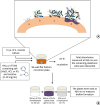1. Aguilar-Zinser V, Irigoyen ME, Rivera G, Maupomé G, Sánchez-Pérez L, Velázquez C. Cigarette smoking and dental caries among professional truck drivers in Mexico. Caries Res. 2008; 42:255–262.


2. Avşar A, Darka O, Topaloğlu B, Bek Y. Association of passive smoking with caries and related salivary biomarkers in young children. Arch Oral Biol. 2008; 53:969–974.


3. Campus G, Cagetti MG, Senna A, Blasi G, Mascolo A, Demarchi P, Strohmenger L. Does smoking increase risk for caries? A cross-sectional study in an Italian military academy. Caries Res. 2011; 45:40–46.

4. Jacob N, Golmard JL, Berlin I. Relationships between nicotine and cotinine concentrations in maternal milk and saliva. Acta Paediatr. 2015; 104:e360–e366.

5. Papaseit E, Farré M, Graziano S, Pacifici R, Pérez-Mañá C, García-Algar O, Pichini S. Monitoring nicotine intake from e-cigarettes: measurement of parent drug and metabolites in oral fluid and plasma. Clin Chem Lab Med. 2017; 55:415–423.


6. Shafagoj YA, Mohammed FI, Hadidi KA. Hubble-bubble (water pipe) smoking: levels of nicotine and cotinine in plasma, saliva and urine. Int J Clin Pharmacol Ther. 2002; 40:249–255.


7. Hoffmann D, Adams JD. Carcinogenic tobacco-specific N-nitrosamines in snuff and in the saliva of snuff dippers. Cancer Res. 1981; 41:4305–4308.

9. Dhar P. Measuring tobacco smoke exposure: quantifying nicotine/cotinine concentration in biological samples by colorimetry, chromatography and immunoassay methods. J Pharm Biomed Anal. 2004; 35:155–168.


10. Huang R, Li M, Gregory RL. Effect of nicotine on growth and metabolism of
Streptococcus mutans
. Eur J Oral Sci. 2012; 120:319–325.

11. Li M, Huang R, Zhou X, Zhang K, Zheng X, Gregory RL. Effect of nicotine on dual-species biofilms of
Streptococcus mutans and
Streptococcus sanguinis
. FEMS Microbiol Lett. 2014; 350:125–132.


12. Huang R, Li M, Gregory RL. Nicotine promotes
Streptococcus mutans extracellular polysaccharide synthesis, cell aggregation and overall lactate dehydrogenase activity. Arch Oral Biol. 2015; 60:1083–1090.


13. Li M, Huang R, Zhou X, Qiu W, Xu X, Gregory RL. Effect of nicotine on cariogenic virulence of Streptococcus mutans
. Folia Microbiol (Praha). 2016; 61:505–512.
14. Balhaddad A, Gregory RL. In-vitro model of Scardovia wiggsiae biofilm formation and effect of nicotine. J Dent Res. 2018; 97(Special Issue A):Abstract #0593.
15. Tanaka K, Miyake Y, Nagata C, Furukawa S, Arakawa M. Association of prenatal exposure to maternal smoking and postnatal exposure to household smoking with dental caries in 3-year-old Japanese children. Environ Res. 2015; 143:148–153.


16. Wagenknecht DR, BalHaddad AR, Gregory RL. Effects of nicotine on oral microorganisms, human tissues, and the interactions between them. Curr Oral Health Rep. 2018; 5:78–87.

17. Hirasawa M, Takada K. Susceptibility of
Streptococcus mutans and
Streptococcus sobrinus to cell wall inhibitors and development of a novel selective medium for
S. sobrinus
. Caries Res. 2002; 36:155–160.


18. Twetman S, Linder L, Modéer T. Influence of bacterial cell concentration and inorganic anions on lysis of
Streptococcus mutans BHT by salivary lysozyme. Scand J Dent Res. 1984; 92:533–538.

19. Pollock JJ, Goodman H, Elsey PK, Iacono VJ. Synergism of lysozyme, proteases and inorganic monovalent anions in the bacteriolysis of oral
Streptococcus mutans GS5. Arch Oral Biol. 1983; 28:865–871.


20. Hamada S, Torii M, Kotani S, Masuda N, Ooshima T, Yokogawa K, Kawata S. Lysis of
Streptococcus mutans cells with mutanolysin, a lytic enzyme prepared from a culture liquor of
Streptomyces globisporus 1829. Arch Oral Biol. 1978; 23:543–549.


21. Ligtenberg AJ, Veerman EC, Nieuw Amerongen AV. A role for Lewis a antigens on salivary agglutinin in binding to
Streptococcus mutans
. Antonie van Leeuwenhoek. 2000; 77:21–30.

22. Dashper SG, Reynolds EC. Effects of organic acid anions on growth, glycolysis, and intracellular pH of oral
streptococci
. J Dent Res. 2000; 79:90–96.


23. Radcliffe CE, Akram NC, Hurrell F, Drucker DB. Effects of nitrite and nitrate on the growth and acidogenicity of
Streptococcus mutans
. J Dent. 2002; 30:325–331.


24. Skjörland K, Gjermo P, Rölla G. Effect of some polyvalent cations on plaque formation
in vivo
. Scand J Dent Res. 1978; 86:103–107.

25. Hamama HH, Yiu CK, Burrow MF. Effect of silver diamine fluoride and potassium iodide on residual bacteria in dentinal tubules. Aust Dent J. 2015; 60:80–87.


26. Knight GM, McIntyre JM, Craig GG, Mulyani , Zilm PS, Gully NJ. Differences between normal and demineralized dentine pretreated with silver fluoride and potassium iodide after an in vitro challenge by
Streptococcus mutans
. Aust Dent J. 2007; 52:16–21.


27. Marsh PD, Williamson MI, Keevil CW, McDermid AS, Ellwood DC. Influence of sodium and potassium ions on acid production by washed cells of
Streptococcus mutans ingbritt and
Streptococcus sanguis NCTC 7865 grown in a chemostat. Infect Immun. 1982; 36:476–483.



28. Goodman H, Pollock JJ, Katona LI, Iacono VJ, Cho MI, Thomas E. Lysis of
Streptococcus mutans by hen egg white lysozyme and inorganic sodium salts. J Bacteriol. 1981; 146:764–774.



29. Greger JE, Eisenberg AD. Adenosine 5′-triphosphate content of
Streptococcus mutans GS-5 during starvation in a buffered salt medium. Caries Res. 1985; 19:314–319.


30. Sanui T, Gregory RL. Analysis of
Streptococcus mutans biofilm proteins recognized by salivary immunoglobulin A. Oral Microbiol Immunol. 2009; 24:361–368.


31. Schreiber S, Ronfani L, Ghirardo S, Minen F, Taddio A, Jaber M, Rizzello E, Barbi E. Nasal irrigation with saline solution significantly improves oxygen saturation in infants with bronchiolitis. Acta Paediatr. 2016; 105:292–296.

32. Mahajan VK. Sporotrichosis: an overview and therapeutic options. Dermatol Res Pract. 2014; 2014:272376.

33. Kardalas E, Paschou SA, Anagnostis P, Muscogiuri G, Siasos G, Vryonidou A. Hypokalemia: a clinical update. Endocr Connect. 2018; 7:R135–R146.

34. Demirhan H, Yıldız M, Çelebi ÖÖ, Baz Ş, İnal BB, Yiğit Ö. The role of fetuin-A and electrolytes in the etiology of sialolithiasis. Otolaryngol Head Neck Surg. 2017; 156:840–843.


35. Gulaboglu M, Yildiz L, Gul M, Celebi F, Peker K. Blood and urine iodine levels in patients with gastric cancer. Biol Trace Elem Res. 2006; 113:261–271.

36. Myant NB. Iodine metabolism of salivary glands. Ann N Y Acad Sci. 1960; 85:208–214.








 PDF
PDF Citation
Citation Print
Print





 XML Download
XML Download